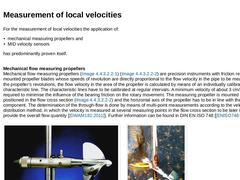
|
For the measurement of local velocities the application of: -
mechanical measuring propellers and
-
MID velocity sensors
has predominantly proven itself.
Mechanical flow measuring propellers
Mechanical flow measuring propellers (Image 4‑204) (Image 4‑205) are precision instruments with friction resistant bearing mounted propeller blades whose speeds of revolution are directly proportional to the flow velocity in the pipe to be measured. From the propeller’…
|
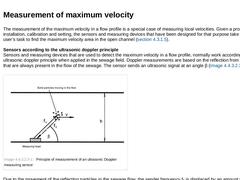
|
The measurement of the maximum velocity in a flow profile is a special case of measuring local velocities. Given a proper installation, calibration and setting, the sensors and measuring devices that have been designed for that purpose take over the user’s task to find the maximum velocity area in the open channel ( (Measuring procedure)).
Sensors according to the ultrasonic doppler principle
Sensors and measuring devices that are used to detect the … |
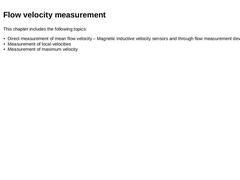
|
|
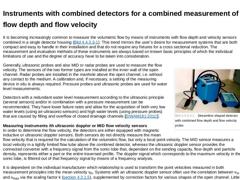
|
It is becoming increasingly common to measure the volumetric flow by means of instruments with flow depth and velocity sensors combined in a single detector housing (Image 4‑208). This trend mirrors the user’s desire for measurement systems that are both compact and easy to handle in their installation and that do not require any fixtures for a cross sectional reduction. The measurement and evaluation methods of these instruments are always based … |
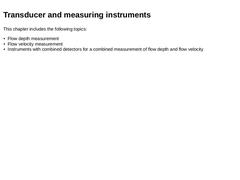
|
|
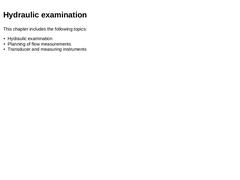
|
|
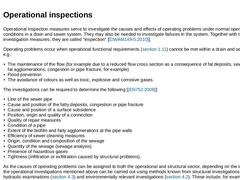
|
Operational inspection measures serve to investigate the causes and effects of operating problems under normal operating conditions in a drain and sewer system. They may also be needed to investigate failures in the system. Together with the structural investigation measures, they are called "inspection" [ [DWAM149-5:2010]]. Operating problems occur when operational functional requirements (section 1.11) cannot be met within a drain and sewer system, … |
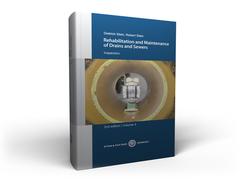
|
Investigation is the first of the four fundamental activities included in integral sewer management. To a reasonable extent, it is to cover all performance aspects of the drain and sewer system in order to create the basis for the next step (the evaluation of the capacity of the drain and sewer system). The obtained results serve to show compliance to due diligence, and also as the basis for the determination of all activities to be carried out with respect to rehabilitation and maintenance. That is why volume 4 of "Rehabilitation and Maintenance of Drains and Sewers" deals with the investigation and inspection. |
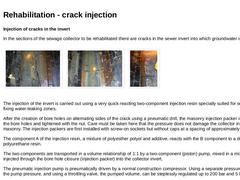
|
Injection of cracks in the invert In the sections of the sewage collector to be rehabilitated there are cracks in the sewer invert into which groundwater is infiltrating. | (Image: Cracked invert before crack injection) |
(Image: Cracked invert before crack injection) |
(Image: Groundwater infiltration at the cracked invert) |
The injection of the invert is carried out using a very quick reacting two-component injection resin specially suited for sealing … |
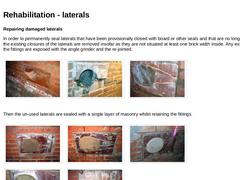
|
Repairing damaged laterals In order to permanently seal laterals that have been provisionally closed with board or other seals and that are no longer in use, first the existing closures of the laterals are removed insofar as they are not situated at least one brick width inside. Any existing cracks in the fittings are exposed with the angle grinder and the re-jointed. | (Image: Fittings of an lateral damaged by cracks or missing shards) |
(Image: Fittings … |
|
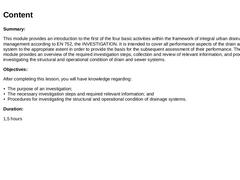
|
Summary: This module provides an introduction to the first of the four basic activities within the framework of integral urban drainage management according to EN 752, the INVESTIGATION. It is intended to cover all performance aspects of the drain and sewer system to the appropriate extent in order to provide the basis for the subsequent assessment of their performance. Therefore, this module provides an overview of the required investigation steps, … |
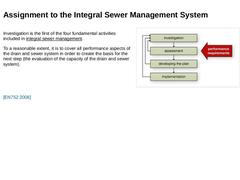
|
Investigation is the first of the four fundamental activities included in integral sewer management. To a reasonable extent, it is to cover all performance aspects of the drain and sewer system in order to create the basis for the next step (the evaluation of the capacity of the drain and sewer system). (Image: Integrated Sewer System Management Process according to DIN EN 752) [EN752:2008] |
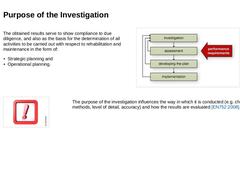
|
The obtained results serve to show compliance to due diligence, and also as the basis for the determination of all activities to be carried out with respect to rehabilitation and maintenance in the form of: -
Strategic planning and
-
Operational planning.
(Image: Integrated Sewer System Management Process according to DIN EN 752) The purpose of the investigation influences the way in which it is conducted (e.g. choice of methods, level of … |
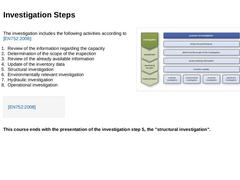
|
The investigation includes the following activities according to [EN752:2008]: -
Review of the information regarding the capacity
-
Determination of the scope of the inspection
-
Review of the already available information
-
Update of the inventory data
-
Structural investigation
-
Environmentally relevant investigation
-
Hydraulic investigation
-
Operational investigation
(Image: Flow chart of the investigation based on EN 752) This course ends … |
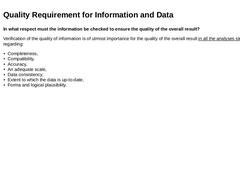
|
In what respect must the information be checked to ensure the quality of the overall result? Verification of the quality of information is of utmost importance for the quality of the overall result in all the analyses steps – regarding: -
Completeness,
-
Compatibility,
-
Accuracy,
-
An adequate scale,
-
Data consistency,
-
Extent to which the data is up-to-date,
-
Forma and logical plausibility.
|
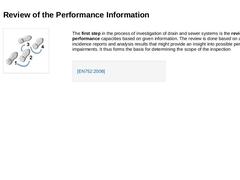
|
The first step in the process of investigation of drain and sewer systems is the review of their performance capacities based on given information. The review is done based on available incidence reports and analysis results that might provide an insight into possible performance impairments. It thus forms the basis for determining the scope of the inspection |
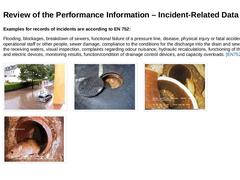
|
Examples for records of incidents are according to EN 752: Flooding, blockages, breakdown of sewers, functional failure of a pressure line, disease, physical injury or fatal accidents of the operational staff or other people, sewer damage, compliance to the conditions for the discharge into the drain and sewer system and the receiving waters, visual inspection, complaints regarding odour nuisance, hydraulic recalculations, functioning of the mechanical … |
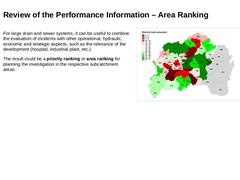
|
For large drain and sewer systems, it can be useful to combine the evaluation of incidents with other operational, hydraulic, economic and strategic aspects, such as the relevance of the development (hospital, industrial plant, etc.). The result could be a priority ranking or area ranking for planning the investigation in the respective subcatchment areas. (Image: Example of an area ranking) |
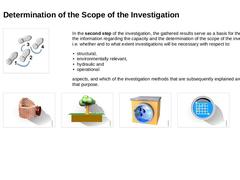
|
In the second step of the investigation, the gathered results serve as a basis for the review of the information regarding the capacity and the determination of the scope of the investigation, i.e. whether and to what extent investigations will be necessary with respect to: -
structural,
-
environmentally relevant,
-
hydraulic and
-
operational
aspects, and which of the investigation methods that are subsequently explained are suitable … |
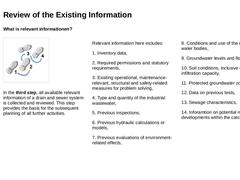
|
What is relevant informationen? (Image: Schritte) In the third step, all available relevant information of a drain and sewer system is collected and reviewed. This step provides the basis for the subsequent planning of all further activities. Relevant information here includes: 1. Inventory data, 2. Required permissions and statutory requirements, 3. Existing operational, maintenance-relevant, structural and safety-related measures for problem solving,… |
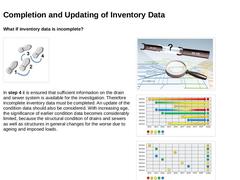
|
What if inventory data is incomplete? (Image: Schritte) In step 4 it is ensured that sufficient information on the drain and sewer system is available for the investigation. Therefore incomplete inventory data must be completed. An update of the condition data should also be considered. With increasing age, the significance of earlier condition data becomes considerably limited, because the structural condition of drains and sewers as well as structures … |
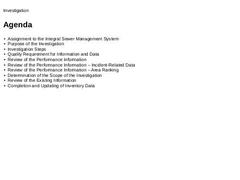
|
|
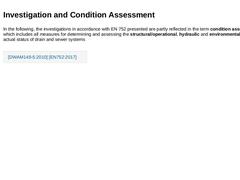
|
In the following, the investigations in accordance with EN 752 presented are partly reflected in the term condition assessment, which includes all measures for determining and assessing the structural/operational, hydraulic and environmentally relevant actual status of drain and sewer systems [DWAM149-5:2010] [EN752:2017] |
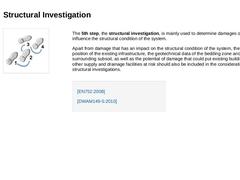
|
The 5th step, the structural investigation, is mainly used to determine damages or defects that influence the structural condition of the system. Apart from damage that has an impact on the structural condition of the system, the age and position of the existing infrastructure, the geotechnical data of the bedding zone and the surrounding subsoil, as well as the potential of damage that could put existing buildings and other supply … |
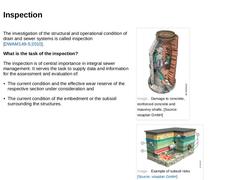
|
The investigation of the structural and operational condition of drain and sewer systems is called inspection [DWAM149-5:2010]. What is the task of the inspection? The inspection is of central importance in integral sewer management. It serves the task to supply data and information for the assessment and evaluation of: |